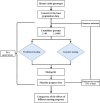Evaluation of genomic mating approach based on genetic algorithms for long-term selection in Huaxi cattle
- PMID: 39587475
- PMCID: PMC11590262
- DOI: 10.1186/s12864-024-11057-9
Evaluation of genomic mating approach based on genetic algorithms for long-term selection in Huaxi cattle
Abstract
Background: Genomic mating (GM) can effectively control the growth rate of inbreeding in population and achieve long-term sustainable genetic progress. However, the design of GM method and assessment of its effects during long-term selection have not been fully explored in beef cattle breeding.
Results: In this study, we constructed a simulated population based on the real genotypes of Huaxi cattle, where five generations of simulated breeding were carried out using the genomic optimal contribution selection (GOCS), genetic algorithms strategy and three traditional mating strategies. During the breeding process, genetic parameters including average genomic estimated breeding value (GEBV), genetic gain values ( ), the rate of inbreeding values ( ) were calculated and compared across generations. Our results showed that the GM method could significantly improve the genetic gain while effectively controlling the inbreeding accumulation within the population. When using the GM method, there was an increase in genetic gain for Huaxi cattle ranging from 1.1% to 25.6% compared to traditional mating strategy, with inbreeding decreasing in the range of 5.8% to 36.2%. Validation using the real dataset from Huaxi cattle further confirmed our findings from the simulated study, offspring populations using the GM strategy exhibited a 7.3% increase in genetic gain compared to positive assortative mating.
Conclusions: These findings suggest that the GM method shows potential for achieving sustainable genetic gain and could be utilized during long-term selection in beef cattle breeding.
Keywords: Genetic algorithms; Genetic gain; Genomic mating; Huaxi cattle; Simulation.
© 2024. The Author(s).
Conflict of interest statement
Declarations. Ethics approval and consent to participate: All of the animal experiments were approved by the Institutional Animal Care and Use Committee (IACUC) at the Institute of Animal Science, Chinese Academy of Agricultural Sciences. All animal procedures were performed in strict accordance with the guidelines proposed by the China Council on Animal Care and the Ministry of Agriculture of the People's Republic of China. We obtained informed consent from the owner of the Huaxi cattle farm to take sample. All methods were carried out in accordance with relevant guidelines and regulations. No euthanasia or anesthesia was used in this study as no invasive procedures or treatments that would require such methods were performed. This study was carried out in compliance with the ARRIVE guidelines (Animal Research: Reporting of In Vivo Experiments). Consent for publication: Not applicable. Competing interests: The authors declare no competing interests.
Figures





Similar articles
-
Genetic gain and inbreeding from simulation of different genomic mating schemes for pig improvement.J Anim Sci Biotechnol. 2023 Jun 13;14(1):87. doi: 10.1186/s40104-023-00872-x. J Anim Sci Biotechnol. 2023. PMID: 37309010 Free PMC article.
-
Evaluation of Linear Programming and Optimal Contribution Selection Approaches for Long-Term Selection on Beef Cattle Breeding.Biology (Basel). 2023 Aug 23;12(9):1157. doi: 10.3390/biology12091157. Biology (Basel). 2023. PMID: 37759557 Free PMC article.
-
The effect of genomic information on optimal contribution selection in livestock breeding programs.Genet Sel Evol. 2013 Oct 30;45(1):44. doi: 10.1186/1297-9686-45-44. Genet Sel Evol. 2013. PMID: 24171942 Free PMC article.
-
[Methods and applications of animal genomic mating].Yi Chuan. 2019 Jun 20;41(6):486-493. doi: 10.16288/j.yczz.19-053. Yi Chuan. 2019. PMID: 31257197 Review. Chinese.
-
Progress in Genomic Mating in Domestic Animals.Animals (Basel). 2022 Sep 6;12(18):2306. doi: 10.3390/ani12182306. Animals (Basel). 2022. PMID: 36139166 Free PMC article. Review.
Cited by
-
Estimation of Genetic Parameters for Body Weight and Its Stability in Huaxi Cows from Xinjiang Region.Animals (Basel). 2025 Jul 31;15(15):2248. doi: 10.3390/ani15152248. Animals (Basel). 2025. PMID: 40805038 Free PMC article.
-
NAD+ Promotes Superovulation of Huaxi Cattle Through Regulation of Cumulus Cell Proliferation and Oocyte Maturation.Int J Mol Sci. 2025 Mar 4;26(5):2276. doi: 10.3390/ijms26052276. Int J Mol Sci. 2025. PMID: 40076893 Free PMC article.
References
-
- Meuwissen T. Maximizing the response of selection with a predefined rate of inbreeding. J Anim Sci. 1997;75(4):934–40. - PubMed
-
- Weigel K. Controlling inbreeding in modern breeding programs. J Dairy Sci. 2001;84:E177–84.
MeSH terms
LinkOut - more resources
Full Text Sources

